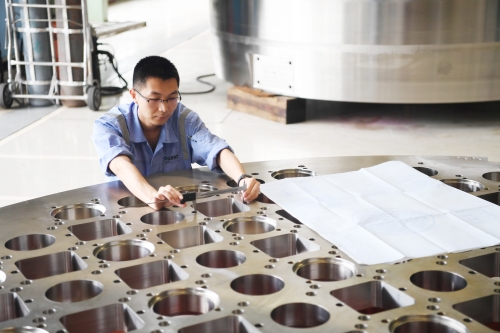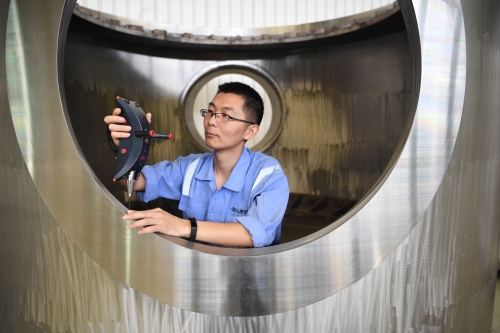Nothing beats firsthand experience.
Since stepping out of his university's gates, and throughout many years learning on the job, this man has always worked hard, stayed practical and resourceful, and continued to develop his career in his role as a nuclear quality inspector. He has made his mark step by step, participating in numerous major national strategic science and technology measurement research projects and working on 33 reactor component inspection projects for second generation plus, third generation plus and fourth generation nuclear power plants. This man, who did not study nuclear power at university, has earned a utility patent for his invention of a laser alignment measurement system and obtained a national invention patent certificate. The compliance rate of his aligned measurement control invention is 100%. Sometimes some people just stand out.
This is Gu Xiaojian, an impartial and incorruptible department chief and a key supporting player in the Belt and Road Initiative.
There are no little things in nuclear.
Attracted by the "awesomeness" of nuclear equipment, Gu Xiaojian studied Mold Design and Manufacturing in the Machinery Department at Nantong Technicians College and graduated in 2007. Thanks to his high scores, a teacher recommended him for an internship at the Shanghai No. 1 Machine Tool Plant where he began his work in assembly testing. The huge volume of process documents and drawings nearly overwhelmed Gu the first day he came to the nuclear site. ing parts standards, checking the measurements in machining procedures, verifying and testing assembly processes, plus on-site technical services... it was all too much. However, these difficulties were not enough to make him turn back.
"Each day, we checked each product and even each procedure based on two principles: 'the three checks' and the 'four must-dos'." After a while, the work became a little monotonous for the young Gu. One time, he slipped up. He measured a part incorrectly, and his normally kind tutor Zhang exploded at him, "Wake up! You can't be even a little sloppy in this kind of work. This stuff is going to be used for nuclear power. If any quality problem in the equipment leads to a major incident, we'll go to prison!" Zhang finished his admonishment with the line, "There are no little things in nuclear."
Faced with this lesson, Gu reflected on his mistakes, asking himself, "Am I doing my job properly? If I relax just one standard, fail to follow just one procedure, or work without reference to the drawings, how can I relax when the power station is put into use?" After he calmed down, he reviewed each type of procedural documents. Every day, he carefully checked drawings and worked hard to build a foundation for himself. He often lingered in the workshop, each day carrying out walking inspections of his work area, checking for potential quality hazards, summarizing, analyzing, and reflecting on his experiences.
"If everyone else can do their job well, I can do it too". He even scratched the phrase "there are no little things in nuclear" into his water bottle. With his new approach and Zhang's guidance, Gu made great strides, in both his attitude to work and his technical skills.
A night owl
"You have to love what you do, and be responsible. You have to be dedicated to this work and do it well," said Gu. He is a man whose actions match his words. After a period of learning, he was recommended again, by Zhang this time, for the post of workshop director. He was in charge of alignment measurement for 300MW guide sleeve parts and barrels.
It's well known that equipment must always be precisely aligned; a difficult enough task. But a huge amount of knowledge and a wealth of hands-on experience are also needed to be able to measure the alignment. For this reason, alignment measurement is generally done by older hands. However, challenges like these only served to arouse Gu's fighting spirit. He set about studying alignment measurement materials while familiarizing himself with the alignment measurement equipment.
When a control rod controlled by precise alignment suddenly drops, it forces an emergency shutdown of the nuclear reactor. Therefore, the production of this component is a hugely important part of the equipment production process. The rod plays a critical role in increasing the efficiency and guaranteeing the safety of the nuclear reactor. In terms of alignment measurement, the challenge is not just the large size of this nuclear reactor component, but also the required precision of the size—to within 0.25 mm. In addition, the concentricity of the top and bottom of the part must be aligned to within 0.25 mm, and the gap between the rod and various embedded parts cannot be off by more than 0.05 mm.
At that time, Gu used optical alignment devices for measuring, which required the use of mercury for reflective imaging. However, the accuracy of the mercury surface is greatly influenced by the environment. "During alignment, you have to make sure the environment does not impact the mercury baseline. You cannot use fans or air conditioning in the workspace, and nobody can move." To reduce the number of outside interferences and to minimize the impact on the normal operations of the workshop, Gu and his team had to do their alignment work at night.
"It normally took until dawn the next day to finish aligning a set of equipment," Gu said. "The quickest we ever did it was five to six hours. But when things didn't go so well, it could keep us busy for three days. My first alignment took a whole three nights to finish." Concentrating on difficult work for long hours is exhausting. Sometimes Gu did not even have clear enough vision or sufficient energy to go back home. But he did not care and never gave up on his work.
So, he studied while he worked, and worked while he studied. If he had a question, he would ask his tutors. His hard work paid off. Gu managed a 100% compliance rate for the alignment data for all of the twenty units he measured. His colleagues had to admire the progress of this young and inexperienced man. "It's thanks to testing nuclear equipment that I've developed the detail-oriented and cautious personality that I have today," said Gu.
Remade by nuclear power
"Our teachers tell us to focus on the details and learn as we go." Gu would work nearly 12 hours a day, doing special tests in the morning and working on aligning projects at night. Alignment is a very technical task. For someone new to the company who is not yet familiar with the work, it is particularly challenging. Once he got started, Gu quickly realized that there was little overlap between his everyday work and what he had learned at school.
In 2010, Gu signed up to sit an exam for on-the-job training from the Shanghai University Machinery Department. Learning on the job was not easy, and especially when he was a front line worker in the workshop. During this time, Gu had nearly no time to rest. His work and study were of a piece. This meant that every little piece of knowledge could be matched to a need in his job, making Gu very happy. After he graduated with a bachelor's degree in Machinery Engineering and Automation from Shanghai University, he did not even stop for breath, next passing the exam for the Senior National Vocational Skills Inspection Certificate. "Studying while working is the best way to learn. I improved the most rapidly in those few years," Gu said. The inspiration he got from his newfound knowledge spurred Gu to keep on going.
During those few years, his technical abilities grew exponentially and he was put in charge of more and more work. From nuclear reactor component assembly, hanging hoop cylinder machining inspections, hoist and experimental reactor shape testing, and ex-factory testing of parts, to API laser trackers, 3D testing of the V-Star industrial testing system product, on site alignment, and nuclear power plant technical support, Gu was firing on all cylinders. Gradually, he became one of the workshop's most capable technical staff members. And thanks to his outstanding work, he was promoted to head of the assembly testing team in the Inspections Department.
However, the stringent environmental requirements for optical alignment devices and long hours spent looking at the optical lens often irritated his eyes and turned them red. After finishing an alignment task, his eyes burned as if he had just chopped some chilies and foolishly touched his eyes. "Could we switch to laser alignment?" he asked himself after finishing an alignment job back in 2013. He rubbed his eyes and thought. If he could use laser alignment, he would not need to stay up all night, and his eyes would not hurt any more.
Gu used his wealth of experience in optical alignment alongside probability calculations and analysis to finally come up with a scientific laser alignment measurement method. This not only increased the accuracy of the alignment measurements, but could also work well with the optical alignment devices. Tests revealed that this laser alignment technology could guarantee a 100% compliance rate for nuclear products, creating powerful safety assurances for on-site installation, debugging and operations at the nuclear island. Happily, Fu and his technical department team were able to jointly apply for a utility patent for "a laser alignment measurement system", obtaining a national invention patent certificate.
The reporter notices that measurement titles such as Optical Measurement Methods, Modern Measurement Technologies, Machinery Measurement Handbook and Laser Trackers can still be seen on Gu's desk. These books, with curled corners and creased spines, not only gave him knowledge, but also allowed him to earn a number of honors.
"Every day I experience the excitement of a challenge and the joy of working with my team"
In May 2015, at the Shanghai No. 1 Machine Tool Plant, production work on the second unit reactor components for China's first third-generation AP1000 nuclear power plant at Sanmen was finished and inspections were passed. It was the first time the production technologies for the third-generation AP1000 nuclear power plant were used in China.
As a participant, Gu had firsthand experience of the production process. The reactor core cover was a 4 meter tall welded component. It had thin walls easily deformed by the welding process. Once welded, force deformation was difficult to control. If any problems occurred during this process, it would have huge consequences. The entire welded structure was to replace the second generation plus wide enclosing panel. This was a disruptive technology. The measurement requirements were different, meaning the measurement methods had to be updated. Gu worked hard to optimize his measurement methods, researching the topic with other technical colleagues. In the end they created a measurement plan that could meet the checking and adjustment requirements of operators. Gu also took part in the quality inspection stage of the adjustment and analysis process for the welding techniques run by the welders, providing valuable support. At the same time, he provided strong assurances in the area of measurement for the company's subsequent mass production.
These are the things that happen daily in the production line. Gu and his colleagues are motivated by their work each day. They welcome new challenges. Gu says, "Every day I experience the excitement of a challenge and the joy of working with my team".
Today, Gu's accomplishments have been recognized across the company and the city of Shanghai. He has bagged a number of different titles from the company and the group, as well as receiving commendations from the city of Shanghai, including "Outstanding Rural Worker", "May 1 Labor Medal" and the "May 4th Youth Medal". Full of emotion, Gu said, "This growth would not have been possible without the training of the company. The continuing development of nuclear energy has also created employees who are willing to think and keen to act."
This is Gu Xiaojian, perceptive, and ever rational.










 Shanghai PNS registry No. 31010102007087
Shanghai PNS registry No. 31010102007087